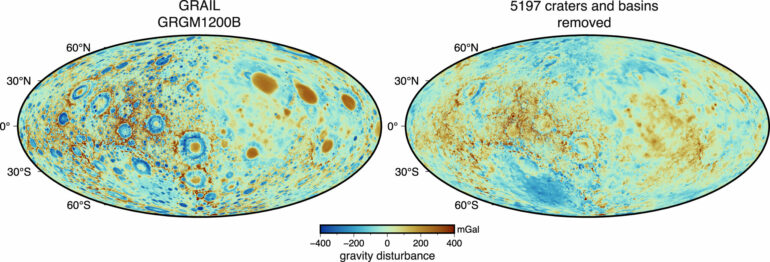The moon’s craters preserve billions of years of history. Scientists have learned about the conditions of our early solar system by studying the composition, size, and distribution of these holes in the moon’s surface, created long ago by collisions with asteroids.
But instead of directly studying the characteristics of these holes, a team based at NASA’s Goddard Space Flight Center in Greenbelt, Maryland, decided to try something different. Using computer simulations, they “erased” thousands of craters from the moon’s surface, as if turning back the clock 4.25 billion years to a time before the craters formed. They found that the locations of the moon’s north and south poles moved slightly over this time period.
As the moon shifted this way and that from the effects of asteroid impacts, the location of the poles “wandered” 10 degrees in latitude (or 186 miles / 300 kilometers), scientists reported on Sept. 19 in The Planetary Science Journal. Geographic north and south poles lie where a celestial body’s rotational axis intersects with its surface. In this case, the moon’s rotational axis, the imaginary line that passes through its center and around which it rotates, stayed the same as the body of the moon shifted.
Information about wandering poles can be useful for understanding the evolution of the moon; specifically, the condition of resources, such as water, on its surface. Scientists have found frozen water in shadowed regions near the moon’s poles, but they don’t yet know how much is there. If the moon had drastically shifted the locations of its poles toward a warmer, less shadowed region, such as the equator, some frozen water could have sublimated (changed from a solid state to a gaseous state) off the surface, with new water having had less time to accumulate at the new poles.
But, says Vishnu Viswanathan, a NASA Goddard scientist who led the study, “Based on the moon’s cratering history, polar wander appears to have been moderate enough for water near the poles to have remained in the shadows and enjoyed stable conditions over billions of years.”
The phenomenon behind the shifting poles is known as True Polar Wander, and it’s what happens under the laws of physics to an object, in this case the moon, that’s trying to keep itself spinning when faced with obstacles, such as changes to the way its mass is distributed.
As asteroid impacts excavated mass, leaving depressions in the surface—or pockets of lower mass—the moon reoriented itself to bring those pockets toward the poles, while bringing areas of higher mass out toward the equator via centrifugal force. It’s the same force that acts on dough when a pizza maker tosses and spins it in the air to stretch it out.
To determine the degree of the moon’s polar wander, Viswanathan partnered with several scientists, including David E. Smith, principal investigator for the Lunar Orbiter Laser Altimeter (LOLA), aboard NASA’s Lunar Reconnaissance Orbiter (LRO) spacecraft. Smith became interested in using gravity data to figure out how far the moon’s poles have wandered after serving as deputy principal investigator of NASA’s Gravity Recovery and Interior Laboratory (GRAIL) mission. GRAIL mapped the moon’s gravity field in great detail before the mission ended in 2012.
“If you look at the moon with all these craters on it, you can see those in the gravity field data,” said Smith, of the Massachusetts Institute of Technology in Cambridge. “I thought, ‘Why can’t I just take one of those craters and suck it out, remove the signature completely?'”
Smith, Viswanathan, and their team worked with about 5,200 craters—ranging in size from 12 miles (20 kilometers) to 746 miles (1,200 kilometers) wide. They designed computer models that took the coordinates and widths of all these craters from topographical maps of the moon made with LOLA data and then found their corresponding gravitational signatures—or pockets of higher or lower gravity—on a gravity map from GRAIL. The scientists then ran simulations that removed the gravitational signatures of each crater sequentially by age, essentially rewinding the evolution of the moon and inching the poles back towards their ancient locations with each impact eliminated.
While other researchers studying polar wander have removed craters from the record, they’ve removed only a couple dozen of the largest ones. “People assumed that small craters are negligible,” said Viswanathan. “They’re negligible individually, but collectively they have a large effect.”
Viswanathan said his team is getting closer to figuring out the true degree of polar wander on the moon, but the scientists still need to refine their estimate. They plan to erase more small craters from the moon and to remove other features, such as volcanic eruptions, that could have contributed to shifting the poles.
“There are a few things that we haven’t taken into account yet, but one thing we wanted to point out is those small craters that people have been neglecting, they actually do matter, so that is the main point here,” said Sander Goossens, a Goddard planetary scientist who participated in the study.
More information:
David E. Smith et al, The Contribution of Small Impact Craters to Lunar Polar Wander, The Planetary Science Journal (2022). DOI: 10.3847/PSJ/ac8c39
Provided by
NASA’s Goddard Space Flight Center
Citation:
Small craters add up to wandering poles on moon, NASA study finds (2022, September 20)



